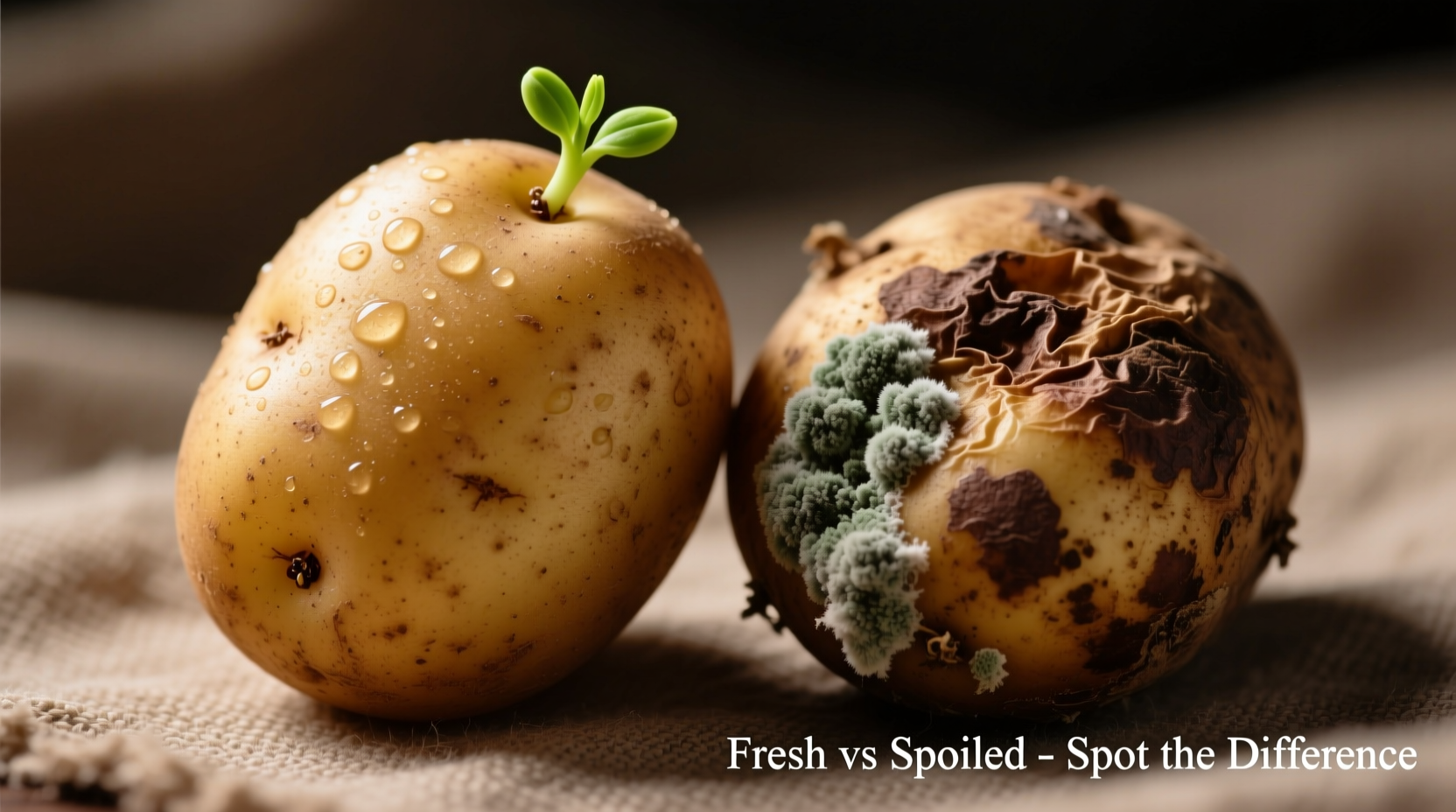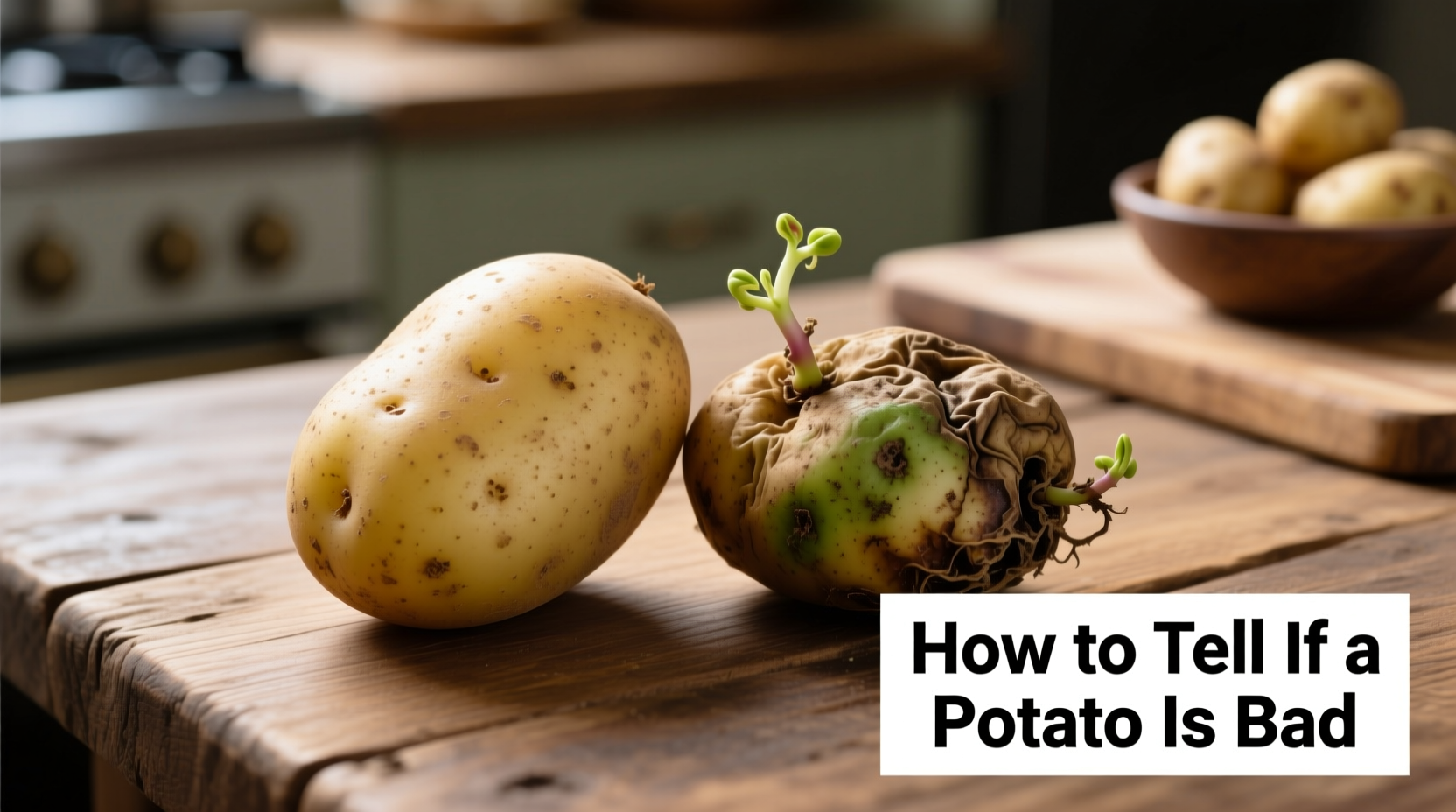Immediate Assessment: What to Do When You Find Potatoes
When you reach for potatoes in your pantry, perform this quick safety check before cooking. The FDA recommends examining all produce for spoilage indicators to prevent foodborne illness. Most consumers waste 30% of edible potatoes by misunderstanding when they're actually unsafe.
Key Spoilage Indicators: Your Visual Inspection Checklist
Follow this step-by-step visual assessment to determine potato safety. Don't rely on just one sign—consider the combination of factors.
| Condition | Safe to Eat? | Action Required |
|---|---|---|
| Small sprouts (¼ inch) | Yes | Remove sprouts completely before cooking |
| Green patches under skin | No | Discard entire potato - indicates solanine buildup |
| Soft but firm texture | Yes | Use immediately - nearing end of freshness |
| Mushy or slimy spots | No | Discard entire potato - bacterial growth present |
| Visible mold | No | Discard immediately - don't attempt to cut away |
Texture and Smell: Critical Warning Signs You Can't Ignore
While visual inspection is crucial, your sense of touch and smell provide vital additional information. According to USDA food safety guidelines, potatoes that feel excessively soft or mushy when gently squeezed have begun breaking down internally. A musty, earthy, or sour odor indicates advanced spoilage that isn't always visible on the surface.
Professional chefs like Antonio Rodriguez recommend the "squeeze test": "Gently press the potato with your fingertips. Fresh potatoes should feel solid with no give. If you feel soft spots or the skin caves in easily, that potato has started to decompose and should be discarded."

When Slightly Imperfect Potatoes Are Still Safe
Not all imperfect potatoes need immediate disposal. The CDC's food safety guidelines clarify that potatoes with minor imperfections can often be salvaged:
- Small sprouts (less than ¼ inch): Remove completely with a vegetable peeler
- Minor surface blemishes: Cut away affected areas with ¼ inch margin
- Slight softness: Use within 24 hours in cooked dishes
However, never attempt to save potatoes showing green discoloration, which indicates solanine—a toxic compound that concentrates in these areas. Solanine isn't destroyed by cooking and can cause food poisoning symptoms including nausea, vomiting, and headaches.
Storage Mistakes That Accelerate Spoilage
Understanding proper storage extends your potatoes' shelf life significantly. Common mistakes include:
- Storing in plastic bags (traps moisture)
- Keeping near onions (accelerates sprouting)
- Refrigerating (causes starch conversion to sugar)
- Exposing to light (triggers greening)
The ideal storage environment maintains 45-50°F (7-10°C) with 90-95% humidity. A cool, dark pantry in a well-ventilated basket typically provides optimal conditions for most households.
Timeline of Potato Spoilage: What to Expect
Understanding the progression of spoilage helps you catch problems early:
- Days 1-7: Peak freshness, firm texture, no sprouts
- Days 8-14: Slight softening, possible small sprouts
- Days 15-21: Noticeable sprouting, possible green patches
- Days 22+: Mushy texture, strong odor, mold development
Refrigeration extends this timeline slightly but changes texture. Never store cut potatoes at room temperature—they spoil within 2 hours according to food safety standards.
Health Risks of Consuming Bad Potatoes
Eating spoiled potatoes isn't just unpleasant—it poses real health risks. The USDA National Agricultural Library reports that solanine poisoning from green potatoes causes gastrointestinal distress in 15,000+ Americans annually. Symptoms typically appear 8-12 hours after consumption and include:
- Nausea and vomiting
- Headaches and dizziness
- Abdominal cramps
- In severe cases, neurological symptoms
Vulnerable populations including children, pregnant women, and immunocompromised individuals face higher risks. When in doubt about a potato's safety, follow the chef's rule: "When uncertain, throw it out."
Maximizing Potato Freshness: Proven Storage Techniques
Extend your potatoes' shelf life with these evidence-based methods:
- Store in a cool, dark place between 45-50°F (7-10°C)
- Use breathable containers like paper bags or wicker baskets
- Keep away from onions and fruits that emit ethylene gas
- Wipe clean with dry cloth—never wash before storage
- Check weekly and remove any showing early spoilage signs
For long-term storage, consider curing potatoes at 50-60°F with high humidity for two weeks before moving to cooler storage. This traditional method, validated by agricultural research, significantly extends shelf life while maintaining quality.
Frequently Asked Questions
Can I eat potatoes with small sprouts?
Yes, potatoes with small sprouts (under ¼ inch) are safe to eat if you completely remove the sprouts and any soft areas around them. The sprouts themselves contain higher concentrations of solanine, so ensure you cut deeply around the sprout base to remove all affected tissue.
Why do potatoes turn green and is it dangerous?
Potatoes turn green when exposed to light, which triggers chlorophyll production and concurrent solanine accumulation. Green areas contain elevated levels of solanine, a natural toxin that isn't destroyed by cooking. Even small green patches indicate potentially dangerous solanine levels, so the entire potato should be discarded.
How long do potatoes last in the pantry?
Properly stored potatoes typically last 2-3 weeks in a cool, dark pantry. Warmer temperatures accelerate sprouting, while refrigeration causes starch conversion to sugar. Check potatoes weekly and remove any showing early spoilage to prevent contamination of the entire batch.
Can I cut mold off potatoes and eat the rest?
No, you should discard moldy potatoes entirely. Unlike hard cheeses, potatoes have high moisture content that allows mold filaments to penetrate deep below the surface. The USDA advises against cutting mold from soft foods like potatoes, as invisible contamination extends far beyond visible mold.
What's the best way to store potatoes long-term?
For long-term storage (2+ months), maintain potatoes at 45-50°F (7-10°C) with 90-95% humidity in a dark, well-ventilated container. Avoid plastic bags—use paper bags or wooden crates. Check weekly for spoilage and never store near onions or fruits that emit ethylene gas, which accelerates sprouting.











 浙公网安备
33010002000092号
浙公网安备
33010002000092号 浙B2-20120091-4
浙B2-20120091-4